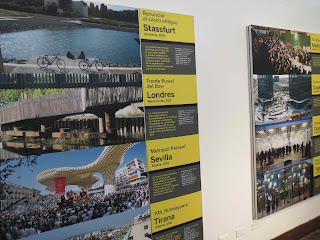 |
Residents in El Parkway, in Teusaquillo,
designed by Austrian architect Karl Brunner. |
Creating and protecting public spaces has been a constant theme in Bogotá's history. City parks and plazas get sliced up by new avenues or invaded by poor homeless people or the cars of the wealthy. Buildings, legal and illegal, march up the city's supposedly protected Eastern Hills, and few protest.
 |
Passers-by watch work on an expansion of
Parque de la Independencia. |
But Bogotá has also created new public spaces, altho almost always amidst controversy. Decades ago, Simon Bolivar Park, larger than New York's Central Park, was laid out in north Bogotá. About a decade ago, the city removed the tombs from the Children's Cemetery on Calle 26 and turned it into the little-used Parque el Renacimiento (Rebirth Park). A few years later, they bulldozed the violent Cartucho neighborhood in the heart of the city and replaced it with Parque Tercer Milenio, which does fill up with children, football players and dog walkers on weekends. Now, workers are bridging over Calle 26 to connect Parque de la Independencia to the Museum of Modern Art, in what is intended to return the park to something like its original shape.
Bogotá's public space has also been boosted over the last decade by the spaces created in conjuction with TransMilenio line construction. A law requiring all new buildings to devote 30 to 40 percent of their areas to public space has been irregularly enforced, according to
El Tiempo.
 |
| Bogotá seen from its Eastern Hills. A very dense city, does Bogotá need more public space? |
But other questions entirely are the condition and maintenance of existing public spaces. Some are invaded by street vendors or parked cars, or made unpleasant by trash and human waste.
 |
In an industrial neighborhood in west-central Bogotá a
metal tree stands in for park space. |
The
Museo de Bogotá in La Candelaria now has an exhibition about award-winning examples of urban public spaces in Europe, which will continue thru mid-April. Creative use of public space played a part in the 'Most innovative city' award won recently by Medellin. In 2007, Bogotá was awarded the Leon de Oro during the Venice Arquitectural Festival.
 |
| Books about public space in the Museo de Bogotá. |
Despite Bogotá's efforts,
El Tiempo reports that the city has less than 4 square meters of public space per resident, whereas international standards recommend 15 square meters per capita. Neighborhoods vary widely. Teusaquillo, for example, has 14.25 square meters of public space per inhabitant, while neighborhoods such as Ciudad Bolivar, which grew informally and chaotically, have little green space. There's also a huge gap between wealthy and poor neighborhoods: The city's wealthy north has much more public space than do poor neighborhoods in its south.
According to
El Espectador, Teusaquillo (which has Simon Bolivar Park within its boundaries) leads the city with 21 square meters of public space per inhabitant. Chapinero has 7.4 square meters, Los Martires 3.3, Ciudad Bolivar 2.9, La Candelaria 2.2, Kennedy 1.4 and Suba only 0.6. The numbers were generated by
MapCity.
The city official best known for creating and improving public spaces was Mayor Enrique Peñalosa, who created Tercer Milenio Park and recovered plazas which had been occupied by illegal vendors. Austrian architect Karl Brunner created the Parkway, a popular park which cuts diagonally thru the Teusaquillo neighborhood.
 |
| Men walk thru Parque Tercer Milenio, created after the El Cartucho neighborhood was bulldozed. Behind them are Bogotá's Eastern Hills, which are slowly being privatized. |
 |
| Young girls pedaling on La Ciclovia, which turns hundreds of kilometers of avenues into recreation space every Sunday. |
 |
| Cyclists on Bogotá's Sunday Ciclovia, which turns hundreds of kilometers of avenues into recreation space. |
 |
| Parque El Renacimiento was created on what was the Children's Cemetery. |
 |
| Privatization of public space by the wealthy: Cars parked on Plaza Santander. |
 |
| An overhead view of the expansion of Parque de la Independencia. |
 |
| Cyclists on Ave. Septima, which has been turned car-free during the day by Mayor Gustavo Petro. |
 |
| A missing monument along Calle 26. |
 |
| Examples of award-winning public spaces in Europe on display in the Museo de Bogotá. |

 |
| Public space created beside a TransMilenio station in central Bogotá. |
 |
| Soccer players in the evening in Parque Tercer Milenio. |
 |
| Factory workers play soccer in a street in an industrial neighborhood of Bogotá with almost no park space. |
 |
| Workers nap during their lunch hour in a pocket park in central Bogotá. |
 |
| Homeless people in the trashy Plaza España. |
 |
| A delapidated bridge in the Parque Nacional in Bogotá. |
 |
| A newly-built pedestrian bridge in central Bogotá. |
By Mike Ceaser, of
Bogotá Bike Tours


























No comments:
Post a Comment